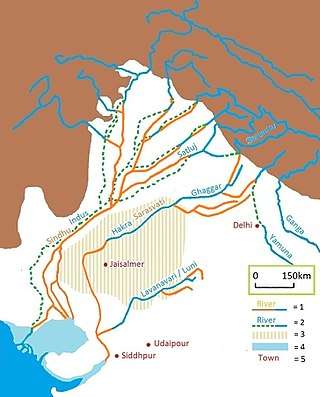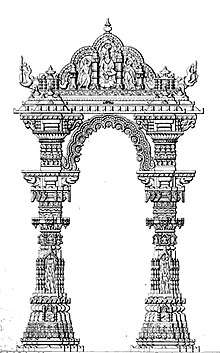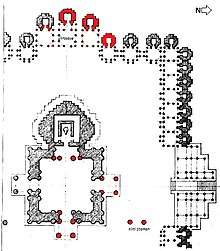Siddhpur
| Siddhpur Sidhpur | |
|---|---|
| City | |
 Siddhpur Location in Gujarat, India  Siddhpur Siddhpur (India) | |
| Coordinates: 23°55′00″N 72°23′00″E / 23.9167°N 72.3833°ECoordinates: 23°55′00″N 72°23′00″E / 23.9167°N 72.3833°E | |
| Country |
|
| State | Gujarat |
| District | Patan |
| Population (2011) | |
| • Total | 61,867 |
| Languages | |
| • Official | Gujarati, Hindi |
| Time zone | UTC+5:30 (IST) |
| PIN | 384151 |
| Telephone code | 02767 |
| Vehicle registration | GJ-24 |

Siddhpur, also spelled Sidhpur is a town and a municipality in Patan district in the Indian state of Gujarat. It is a historical place located on the bank of Sarasvati River. Siddhpur is the headquarters of Siddhpur taluka.
History
Siddhpur was historically known as Sristhal,[1] literally "a pious place".
The bard sings of it,[1]
Tirath bhumipavan Siddhakshetra subhasar,
Nirmal nir vahe Sarasvati sada mokshko dwar, ... —
"A Tirtha, a place to make holy, is the good Siddha Kshetra,
Where flows Sarasvati's pure stream — ever beatitude's door.
A city three worlds to purify, by Siddhs ever worshipped,
Gods, Rishis, and men cherish the desire to live there.
And there dwell devas unnumbered, as a tirtha regarding it, —
Of Kasi, Gaya, Godavari, and all other tirthas, the best ;
Where Kardam and Dehuti lived, and Kapila was born.
Here is Bindusarovar's pure fount, and Matrugaya;
Applied to the bodies of men degraded and fallen, it washes their myriads of sins.
Here is Prachi Mahadev, whose renown by Veda and Purana is sung:
Of all Tirthas, the essence — it is named Kapilashram."
In tenth century (943 AD), Mularaja, the founder of Chaulukya dynasty, started constructing the Rudra Mahalaya Temple.[1] On completion of the temple, around 1140 AD, Jayasimha Siddharaja consecrated it and established the town as his capital. He changed its name to Siddhpur, literally Siddhraj's town.[1] The temple was dismantled by an army under Almas Beg (Ulugh Khan) and Nusrat Khan sent by Alauddin Khalji in 1298-99.[1]
During the Gujarat Sultanate, the town was under the rule of local dynasty ruling from Palanpur. In the 15th century, the town was brought under the Mughal rule by Akbar. Under the Mughal rule the town developed and flourished.
Asaita Thakar, traditionally credited for the origin of traditional folk theatre Bhavai, in 14th century, lived in Siddhpur.[2]
Climate and weather
The climate of Siddhpur is continental. The summer season is hot and dry, with temperature in the range of 40°. While in winter it is pleasant with temperatures in 20°. The average annual rainfall is 40-50 inches.
Demographics
At the 2001 census of India,[3] Siddhpur had a population of 53,581, of which 52% were male and 48% female. Siddhpur had an average literacy rate of 71%, higher than the national average of 59.5%: male literacy was 77%, and female literacy was 64%. In Siddhpur, 12% of the population is under 6 years of age.
Attractions
| |||||
Sidhpur has two protected monument under Archaeological Survey of India (ASI) namely: Ruins of Rudra Mahalaya Temple and the Jami Masjid.[4] The city is also known for his havelis in hacienda architecture largely belonging to Dawoodi Bohra community and spread over 18 mohallas or neighbourhoods.[5]
- Bindu-Sarovar: It is a small artificial tank, even mentioned in Rig-veda and considered pious by Hindus. According to Hindu theology, there are five sacred lakes; collectively called Panch-Sarovar; Mansarovar, Bindu Sarovar, Narayan Sarovar, Pampa Sarovar and Pushkar Sarovar.[6] They are also mentioned in Shrimad Bhagavata Purana.[7][8][6] Matrushradh, Mother Moksha /Tarpan on Saraswati river (Rig-Veda) an ancient Hindu culture. one of the famous place to visit in the Siddhpur. Sage Kapil had founded Sankhya Sastra, and Mother Devahuti got Moksha, Explained the Sankhya Darshan by his son (Kapila) on the Saraswati bank: Since the Moksha of Devhuti established this place Bindu Sarovar in Siddhpur an only place in India where Matru-shradh is being carried out, thus thousands of people come here annually to perform the rituals for their dead mothers, in month of Kartik of Hindu calendar. History says the Lord Parshuram had worship here for his sins and done the Matrushradh for his Mother. Moksha Karmakand by brahman priest on Saraswati river at pipal tree of Siddheswar temple possesses ancient place of God Vishnu. Rig-Ved mentioned for ancient Sristhal and Saraswati river.
- Siddhpur have the magnificent and beautiful havelis or medieval homes of Bohra traders. They are famous for their delicate wooden architecture and interior decoration of medieval style of India.
- Arvadeswar temple of Lord Shiv at Siddhpur is a very ancient place of Nath sampradaya in this place Late Devshankarbapa Bhatt who had worshiped 50 years and Died in 1978.
- Tower of Sidhpur, built by Mr. Muhammadali Hararwala (Rajaratnam) on 4 April 1915. That time built cost of the tower was Rs. 15000.00 during the rule of Gaekwad.
- The Siddhpith is established by Devshankarbapa. Where Vedic activities, Archana of Lord Shiva like Laghurudra, Maharudra, Atirudra. Daily Agnihotra and Gayatri chants are being carried out by Brahmin Priest Shri Vikrambhai Pancholi at present. At Siddhpith annually pilgrims/Devotees from India come at birth, Death anniversary of Devshankarbapa. Siddhpith had a place of Rushi Kardama's worship spot, and evidence of ancient history being the Lord Brahma's visit The Siddheswar temple on Saraswati river, Chandrakant Pathak (Chanduguru) great human devotee of Dutta, Ved Pathi, Brahmchari established Guru-Sishya Parampara here after Lord Krishna-Sandipani. Thousands of Rushiputra/Brahman priest learned in free gurukul since 200 years at the same place and developed Brahmtej.
Politics
Sidhpur is a constituency of the Gujarat Legislative Assembly within the Patan (Lok Sabha constituency).[9]
See also
References
- 1 2 3 4 5 Burgess; Murray (1874). "The Rudra Mala at Siddhpur". Photographs of Architecture and Scenery in Gujarat and Rajputana. Bourne and Shepherd. p. 19. Retrieved 23 July 2016.
- ↑ Amaresh Datta (1987). Encyclopaedia of Indian Literature: A-Devo. Sahitya Akademi. p. 236. ISBN 978-81-260-1803-1.
- ↑ "Census of India 2001: Data from the 2001 Census, including cities, villages and towns (Provisional)". Census Commission of India. Archived from the original on 2004-06-16. Retrieved 2008-11-01.
- ↑ Alphabetical List of Monuments - Gujarat. Rudra Mahalaya Temple is a unique place to visit to see the spectacular crafts on sandstones but as the issue is pending in court about the religious authority, the entry is restricted in the area of Rudra Mahal. Archaeological Survey of India.
- ↑ "Ghost town of Gujarat". Indian Express. 29 June 2003. Retrieved 25 January 2013.
- 1 2 Encyclopaedia of tourism resources in India, Volume 2 By Manohar Sajnani
- ↑ "Narayan Sarovar Temple in Kutch ~ KACHCHH GUIDE". Kutchguide.blogspot.com. 2010-12-19. Retrieved 2015-07-27.
- ↑ "Kutch Visiting Places and Tourist Attraction : Kutch Guide - Gujarat". Gujaratguideonline.com. Retrieved 2015-07-27.
- ↑ "Gujarat election results: List of winners". Jagran Post. 20 December 2012. Retrieved 25 January 2013.
External links

- Images of Sidhpur Trek Earth
![]()



